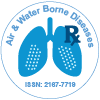开放获取期刊获得更多读者和引用
700 种期刊 和 15,000,000 名读者 每份期刊 获得 25,000 多名读者
索引于
- 哥白尼索引
- 谷歌学术
- 夏尔巴·罗密欧
- 打开 J 门
- Genamics 期刊搜索
- 学术钥匙
- 乌尔里希的期刊目录
- 参考搜索
- 哈姆达大学
- 亚利桑那州EBSCO
- OCLC-世界猫
- 日内瓦医学教育与研究基金会
- ICMJE
有用的链接
开放获取期刊
分享此页面
抽象的
Dimensions of Effects of Climate Change on Water-Transmitted Infectious Diseases
Marieta AH Braks and Ana Maria de Roda Husman
Human pathogens that are water-transmitted may follow various routes, ranging from water ingestion to transmission via insect vectors. Since water-transmitted pathogens are highly influenced by climate and environmental conditions, any climate change may alter the infectious disease burden from exposure to these pathogens. Climate factors determine the number, type, virulence and infectivity of pathogens transmitted through water or vectors that breed in water, and thus may have an impact on resulting infectious diseases. In this perspective, the most important climate factors are temperature, relative humidity, UV radiation, precipitation patterns and water availability. Some indigenous species of bacteria, amoebas and algae are able to grow in aquatic environments with higher temperatures, whereas enteric bacteria, viruses and parasites that are derived from human or animal faeces are not. Increased UV radiation may result in increased inactivation of enteric pathogens, or alternatively growth, whereas increased precipitation intensity will lead to peak concentrations of these pathogens due to e.g. sewage overflow and runoff. For mosquito borne disease, high spatio-temporal variation and uncertainties in the many variables that determine their emergence preclude general projections in the future. Climate factors not only affect pathogen behaviour, but also influence human behaviour, thus stressing the need to study both the complexity of pathogen behaviour and social behaviour with respect to expected climate changes.

 English
English  Spanish
Spanish  Russian
Russian  German
German  French
French  Japanese
Japanese  Portuguese
Portuguese  Hindi
Hindi